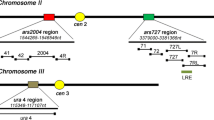Summary
A HeLa DNA fragment, which may function as an anchorage point to the nuclear matrix for human chromosomes 1 and 2, also functions as an autonomously replicating sequence (ARS) in the yeast Saccharomyces cerevisiae. In the present report we show that this DNA fragment contains both bent DNA and an A-T rich region which appear to be associated with the ARS function. More interestingly, DNA sequence analysis shows that the spatial distribution of these features is strikingly similar to that found in the yeast ARS1 element.
Similar content being viewed by others
References
Aguinaga MdP, Kiper CE, Valenzuela MS (1987) Enriched autonomously replicating sequences in a nuclear matrix-DNA complex isolated from synchronized HeLa cells. Biochem Biophys Res Commun 144:1018–1024
Aguinaga MdP, Sharan C, Singh DN, Kegler D, Siddiqui KAI, Valenzuela MS (1989) Chromosomal mapping and nucleotide sequence of a human DNA autonomously replicating sequence. Genomics 5:605–611
Brewer BS, Fangman WL (1987) The localization of replication origins on ARS plasmids in Saccharomyces cerevisiae. Cell 51:463–471
Broach JR, Li YY, Feldman J, Jayaran M, Abraham J, Nasmyth KA, Hicks JB (1983) Localization and sequence analysis of yeast origins of replication. Cold Spring Harbor Symp Quant Biol 47:1165–1173
Campbell JL (1988) Eucaryotic DNA replication: yeast bares its ARSs. TIBS 156:212–217
Dugaiczyk A, Boyer HW, Goodman HM (1975) Ligation of EcoRI endonuclease-generated DNA fragments into linear and circular structures. J Mol Biol 96:171–184
Huberman JA, Spotila LD, Naowstka KA, El-Assoli SM, Davis LR (1987) The in vivo replication origin of the yeast 2 μ plasmid. Cell 51:473–481
Huberman JA, Zhu J, Davis LR, Newlon CS (1988) Close association of a DNA replication origin and an ARS element on chromosome III of the yeast Saccharomyces cerevisiae. Nucleic Acids Res 16:6367–6384
Littlewood RK, Inman RB (1982) Computer-assisted DNA length measurements from electron micrographs with especial reference to partial denaturation mapping. Nucleic Acids Res 10:1891
Marini JC, Levene SD, Crothers DM, Englund PT (1982) Bent helical structure in kinetoplast DNA. Proc Natl Acad Sci USA 79:7664–7668
Newlon CS (1988) Yeast chromosome replication and segregation. Microbiol Rev 52:568–601
Palzkill TG, Newlon CS (1988) A yeast replication origin consists of multiple copies of a small conserved sequence. Cell 53:441–450
Snyder M, Buchman AR, Davis RW (1986) Bent DNA at a yeast autonomously replicating sequence. Nature 324:87–89
Srienc F, Bailey JE, Campbell JL (1985) Effect of ARS1 mutations on chromosome mutations in Saccharomyces cerevisae. Mol Cell Biol 5:1676–1684
Stinchcomb D, Struhl K, Davis RW (1979) Isolation and characterization of a yeast chromosomal replicator. Nature 282:39–43
Stinchcomb DT, Thomas M, Kelly J, Selker E, Davis RW (1980) Eucaryotic DNA segments capable of autonomous replication in yeast. Proc Natl Acad Sci USA 77:4559–4563
Tschumper G, Carbon J (1980) Sequence of a yeast fragment containing a chromosomal replicator and the TRP1 gene. Gene 10:157–166
Tschumper G, Carbon J (1982) Delta sequences and double symmetry in a yeast chromosomal replicator region. J Mol Biol 156:293–307
Umek RM, Kowalski D (1987) Yeast regulatory sequences preferentially adopt a non-B conformation in supercoiled DNA. Nucleic Acids Res 15:4467–4480
Umek RM, Kowalski D (1988) The ease of unwinding as a determinant of initiation of yeast replication origins. Cell 52:559–567
Valenzuela MS, Inman RB (1981) Direction of bacteriophage DNA replication in a thymine requiring Escherichia coli K-12 strain. Effect of thymine concentration. Nucleic Acids Res 9:6975–6984
Waterman MS (1983) Frequencies of restrictions sites. Nucleic Acids Res 11:8951–8956
Wu H, Crothers DM (1984) The locus of sequence-directed and protein-induced DNA bending. Nature 308:509–513
Zahn K, Blattner FR (1985) Sequence-induced DNA curvature at the bacteriophage λ origin of replication. Nature 317:451–453
Author information
Authors and Affiliations
Additional information
Communicated by K. Illmensee
Rights and permissions
About this article
Cite this article
Valenzuela, M.S. An autonomously replicating sequence from HeLa DNA shows a similar organization to the yeast ARS1 element. Mol Gen Genet 220, 361–365 (1990). https://doi.org/10.1007/BF00391739
Received:
Issue Date:
DOI: https://doi.org/10.1007/BF00391739



